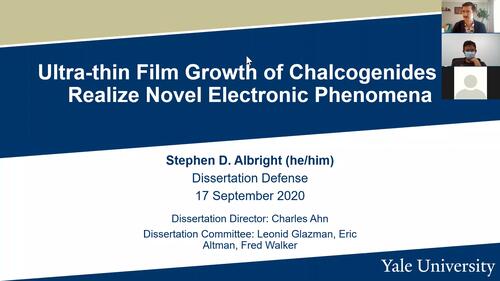
On September 17, 2020, Stephen Albright successfully defended his thesis, “Ultra-thin Film Growth of Chalcogenides to Realize Novel Electronic Phenomena” (Advisor: Charles Ahn).
Albright explained, “In order to continue the steady advancement of computational power over the past half century, we must find new materials to move beyond the current electronics used in computers. Chalcogenides, or compounds containing sulfur, selenium, or tellurium, contain several novel materials that could address this need, like superconductors or topological insulators. In my thesis, I describe fundamental studies of several promising chalcogenides, from synthesis methods for crystals as thin as a single molecular layer to numerous characterization techniques to understand the crystal structure and basic physical properties of the thin chalcogenide films. This work builds a foundation from which future work can find new high-Tc superconductors or develop devices like dissipationless nanowires or topological transistors.”
Albright is still planning his future activities.
Thesis Abstract: Chalcogenides, compounds containing the elements S, Se, or Te, are a class of materials that includes those with two-dimensional materials properties that have been shown to exhibit novel electronic phenomena, including superconductivity and non-trivial topology. These properties are both intrinsically valuable to our continuing fundamental understanding of electronic behavior in materials and potentially useful in developing next-generation electronic devices. In this dissertation I describe the techniques necessary to synthesize ultra-thin films of four chalcogenide systems of sufficient quality to display their unique properties.
In my first study, I find careful substrate surface preparation as the key to growing FeSe, a monolayer superconductor that requires a double-layer TiO2 terminated surface of SrTiO3. In my second study, of Bi2Te3, a layered topological insulator that requires reconstructed surfaces of Si or Ge substrates, I demonstrate a proce dure to protect chalcogenide films from oxidation by capping with amorphous Se or Te. My third study, of stanene, a Sn-based analog of graphene that is predicted to be a topological insulator, identifies the chemical reactions that occur when Sn is deposited on Bi2Te3 that prevent formation of a stanene monolayer. Finally, in my fourth study, I present the steps necessary to synthesize uniform and continuous topological crystalline insulator SnTe films on SrTiO3 and I characterize the topological states present at the SnTe/SrTiO3 interface. I utilize molecular beam epitaxy deposition processes to synthesize each chalcogenide ultra-thin film and use a suite of complementary techniques, including diffraction, spectroscopy, electrical transport measurements, and microscopy to characterize the deposited films.
The findings presented here demonstrate the strong dependence of chalcogenide superconductors and topological insulators on their interfacial structure. Correspondingly, the results highlight the sensitivity of chalcogenides to growth conditions, and thus the care necessary to achieve uniform ultra-thin films appropriate for measurement and functionalization. The precise nature of the interplay between electronic properties and interfacial structure in chalcogenides provides a critical foundation for understanding the origins of these phenomena and how to adapt these materials into functional devices.